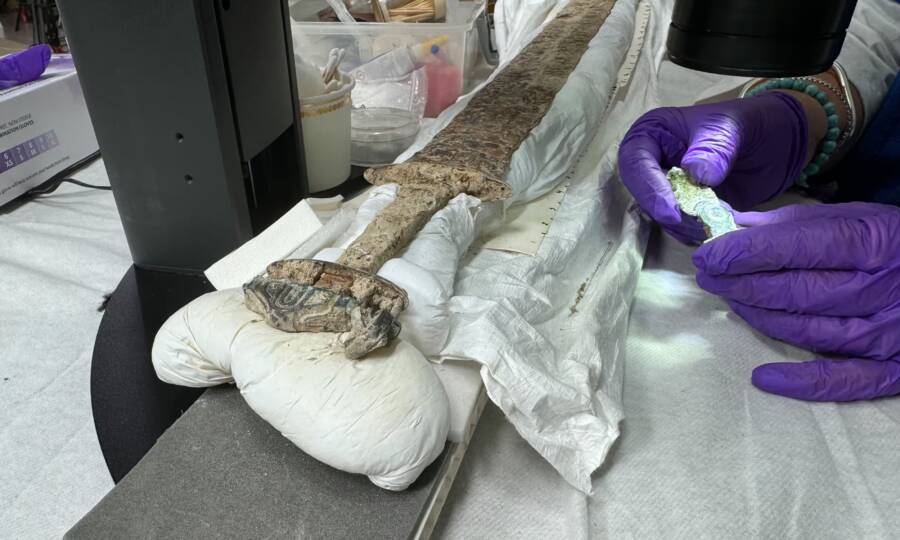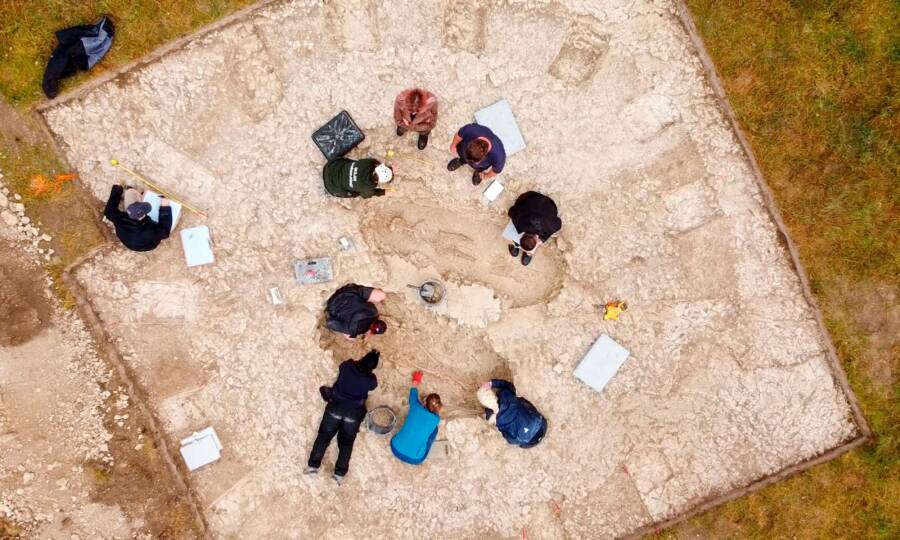While excavating an early medieval cemetery in Kent, researchers discovered a 1,500-year-old sword inside an Anglo-Saxon grave.

Prof Alice Roberts/BBC/Rare TVThe remarkably well-preserved sword found at an Anglo-Saxon cemetery in Kent, England.
An exceptionally well-preserved sword dating back to the sixth century C.E. was recently unearthed in Kent, England. Found at the site of an Anglo-Saxon cemetery, the sword has drawn several comparisons to the famous Anglo-Saxon sword found in 1939 at Sutton Hoo, a burial ground in Suffolk.
The newly discovered sword has a silver-and-gilt hilt featuring an intricately decorated pattern, while the blade itself is embossed with a runic script. Additionally, archaeologists found remains of the sword’s leather-and-wood scabbard, lined with beaver fur, and a symbolic ring attached to its pommel.
The sword is just one of several remarkable objects found at the dig site near Canterbury. The exact location of the site, however, is being withheld as further excavations are planned. So far, 12 burials have been excavated, though researchers believe there may be more than 200 others in the area, all dating between the fifth and sixth centuries.
The Medieval Sword Found During Excavations Of An Anglo-Saxon Cemetery

Trustees of the British MuseumThe famous sword found at a ship-burial site in Sutton Hoo.
The sword was discovered in a burial that also contained a gold pendant, decorated with the likeness of what appears to be a great serpent or a dragon. Typically, these pendants were worn by women of high status, suggesting this particular one may have been a treasured keepsake from a relative or ancestor.
As for the sword itself, however, Sayer described it as “really incredible, in the top echelons of swords, an elite object in every way, which is wonderful.”
So far, archaeologists have excavated 12 graves at the site, coming across a wealth of treasures. Among the finds were various spears, shields, knives, brooches, buckles, and other objects.
However, they are keeping the name of the site “under wraps,” Sayer said. “It’s a very rich cemetery. It would be a real tragedy if it became well known before we’ve excavated it.”
Many of the discoveries will be featured on the upcoming 12th season of BBC Two’s Digging for Britain, with other experts weighing in on the impressiveness of the sword in particular.
How These 1,500-Year-Old Burials Are Shedding New Light On England’s Past
These excavations are part of a much larger project to document and observe a long-purported “great migration” of Anglo-Saxons across Britain following the end of the Roman era. Previously, this concept was nothing more than a theory, but after a study of 300 early Anglo-Saxons across the east coast of Britain showed that roughly 75 percent of their DNA came from continental Europe, experts became more confident in pursuing this theory.
“Before we published those results, there was still quite a lot of conversation about whether there really was a significant migration,” Duncan Sayer, lead archaeologist and professor from the University of Central Lancashire, told The Guardian. “Now it’s absolutely definite that there has to have been a very significant influx, especially in the east coast taking place over generations. They’re not coming from one place, but multiple places. This cemetery is right at the cutting-edge of that work.”

Production/BBC/Rare TVExperts at the Anglo-Saxon burial site uncovered near Canterbury.
Archaeologists have only explored a small portion of the cemetery, noting that they believe there could be more than 200 other burials awaiting excavation. Still, even from the small bit they have excavated, it’s clear that the site holds a trove of valuable artifacts that offer a deeper glimpse into the past.
“It’s an extraordinary Anglo-Saxon cemetery,” said professor Alice Roberts, host of the docuseries, “with really beautifully furnished graves, a lot of weapon burials where you find things like iron spear-points and seaxes, which are Anglo-Saxon knives — and then there’s this astonishing sword.”
Roberts said she had never before seen a sword “that’s so beautifully preserved,” but this is not the only remarkable discovery experts have made at the site. In fact, new advances in technology have made it possible for experts to examine the burials in greater detail than ever before — leading to some fascinating, if somewhat unconventional, observations.
For instance, conservator Dana Goodburn-Brown used a microscope to examine the sword at a magnification of more than 10 times, which found stunning details that were undetectable to the human eye. One such detail, she noted, was the presence of fly pupae on the sword, suggesting that the body had not been immediately covered before being buried, hinting at funerary practices where loved ones said their goodbyes before burial.
Other graves from the fifth century contained various artifacts from Scandinavia, while sixth-century graves contained many artifacts of Frankish origin, once again highlighting the great migration that occurred at the time.
While there is still much work to be done, experts did announce that they plan to thoroughly preserve the sword and other artifacts. Hopefully, as the excavations continue, they can discover even more about England’s Anglo-Saxon past.
After reading about the discovery of this immaculate sixth-century sword, learn all about the legend of King Arthur’s famous sword, Excalibur. Then, learn about the famous Durandal sword, known as the “French Excalibur.





